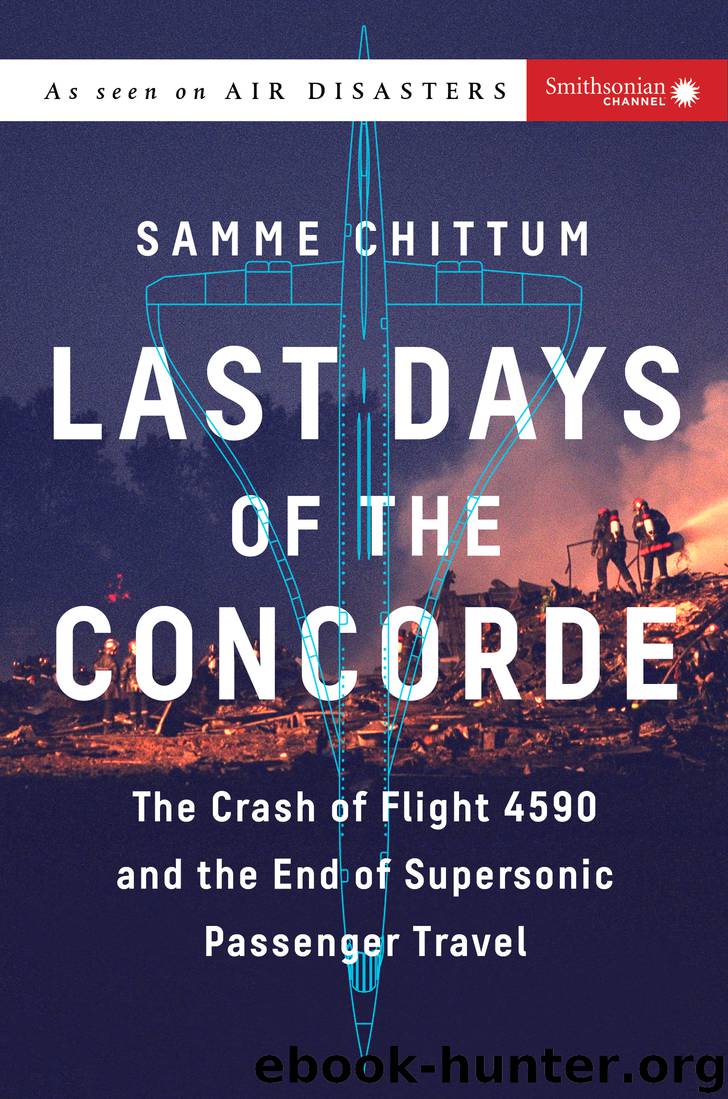Last Days of the Concorde by Samme Chittum

Author:Samme Chittum
Language: eng
Format: epub
Publisher: Smithsonian
Published: 2018-09-24T16:00:00+00:00
9
Delays and Headaches
In his moving accounts of his aeronautical adventures, ace pilot and author Antoine de Saint-Exupéry displayed an uncanny ability to be at once philosophically detached and viscerally engaged with the experience of flying, its joys and perils, and what it taught him about life and death. “And there I stayed a bit, ruminating, and telling myself that a man was able to adapt himself to anything,” he wrote in one of his great works, the 1939 memoir Wind, Sand, and Stars. “The notion that he is to die in thirty years has probably never spoiled any man’s fun. Thirty years, or thirty days…it’s all a matter of perspective.” Saint-Exupéry saw clearly and unflinchingly what was close at hand, but he also looked to the stars for solace. In the process, he became one of the most eloquent chroniclers of what it was like to fly into an impenetrable fog, to crash-land in the Sahara Desert, or to be stranded in a disabled plane atop a remote, frozen plateau without hope of rescue.
The modern world in which the Concorde flight crew lived and worked would have been at once familiar and strange to Saint-Exupéry, who was born in the year 1900 and lived only until 1944, when his Lockheed P-38 Lightning vanished during a reconnaissance mission off occupied France. Although he died in the service of the Free French military, Saint-Exupéry—like Christian Marty and his fellow pilots—spent most of his working life in the field of civil aviation, making long, perilous night flights over the towering Andes and the vast Sahara as a pilot for the French air mail service. He got his start in 1926 flying for the Compagnie Aérienne Française, a small airline based at Le Bourget Airport. Paris was his off-and-on-again home, and he even worked briefly in the public-relations department of Air France.
The balky, primitive planes he flew—propeller-powered Sopwith biplanes and triplanes with few instruments—bore no resemblance to the supersonic Concorde. But he surely would have been enraptured with the prospect of soaring high enough to explore the stratosphere and marvel at the curve of the Earth. His awe of the first supersonic passenger plane doubtless would have been tempered by his knowledge that it was no more than a machine built for travel. “The airplane,” he wrote, “is a means, not an end.” Its higher, overlooked purpose—to reveal “the true face of the Earth”—was open to discovery by a privileged few: pilots who were, like Marty, both disciplined and thoughtful.
Saint-Exupéry certainly would have appreciated the depth of comradeship that existed among three seasoned professionals working together in the confines of the claustrophobic Concorde cockpit. And he knew what it was to watch a friend climb confidently into the pilot’s seat before flying off into perfect blue skies, never to return. “For nothing, in truth, can replace that [lost] companion,” he wrote. “Old friends cannot be created out of hand. Nothing can match the treasure of common memories, of trials endured, of quarrels, reconciliations, and generous emotions.
Download
This site does not store any files on its server. We only index and link to content provided by other sites. Please contact the content providers to delete copyright contents if any and email us, we'll remove relevant links or contents immediately.
| Automotive | Engineering |
| Transportation |
Whiskies Galore by Ian Buxton(41720)
Introduction to Aircraft Design (Cambridge Aerospace Series) by John P. Fielding(33017)
Small Unmanned Fixed-wing Aircraft Design by Andrew J. Keane Andras Sobester James P. Scanlan & András Sóbester & James P. Scanlan(32685)
Craft Beer for the Homebrewer by Michael Agnew(18082)
Turbulence by E. J. Noyes(7895)
The Complete Stick Figure Physics Tutorials by Allen Sarah(7265)
Kaplan MCAT General Chemistry Review by Kaplan(6823)
The Thirst by Nesbo Jo(6759)
Bad Blood by John Carreyrou(6477)
Modelling of Convective Heat and Mass Transfer in Rotating Flows by Igor V. Shevchuk(6354)
Learning SQL by Alan Beaulieu(6159)
Weapons of Math Destruction by Cathy O'Neil(6085)
Man-made Catastrophes and Risk Information Concealment by Dmitry Chernov & Didier Sornette(5878)
Digital Minimalism by Cal Newport;(5588)
Life 3.0: Being Human in the Age of Artificial Intelligence by Tegmark Max(5405)
iGen by Jean M. Twenge(5326)
Secrets of Antigravity Propulsion: Tesla, UFOs, and Classified Aerospace Technology by Ph.D. Paul A. Laviolette(5237)
Design of Trajectory Optimization Approach for Space Maneuver Vehicle Skip Entry Problems by Runqi Chai & Al Savvaris & Antonios Tsourdos & Senchun Chai(4957)
Electronic Devices & Circuits by Jacob Millman & Christos C. Halkias(4866)
